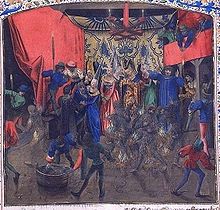- Master of Anthony of Burgundy
-
 The Master's depiction from the 1470s of the Bal des Ardents, from BnF Fr 2646, shows his qualities well. Despite fading, it is "a veritable tour de force in the handling of space, forms, light and emotion"[1]
The Master's depiction from the 1470s of the Bal des Ardents, from BnF Fr 2646, shows his qualities well. Despite fading, it is "a veritable tour de force in the handling of space, forms, light and emotion"[1]
The Master of Anthony of Burgundy was a Flemish miniature painter active in Bruges between about 1460 and 1490,[2] apparently running a large workshop, and producing some of the most sophisticated work of the final flowering of Flemish illumination.[3] He was first identified by Winkler in 1921; his name is derived from one of his most elevated patrons, Anthony of Burgundy, Philip the Good's illegitimate son, though he also worked for the Dukes and other bibliophiles in Burgundian court circles, who had already been allocated "Masters" by art historians. His contributions to the heavily illustrated Froissart of Louis of Gruuthuse (BnF Fr 2643-6) from the early 1470s, on which several of the leading illuminators of the day worked, show him excelling some more famous names, like Loiset Lyédet. The young Master of the Dresden Prayer Book worked as his assistant on this book, suggesting he was an apprentice; a number of other anonymous masters have been postulated as his pupils.[4] Other works are in the libraries of Paris, Wrocław, Philadelphia, Munich, Cambridge University Library and elsewhere.
He sometimes painted using gold and silver on a black background, as in the Vienna Black Hours (or Sforza Hours and other titles) now in Vienna. It is through the somewhat controversial attribution of that book to him, and its further identification with a book presented to Charles the Bold and known to have been illustrated by Philippe de Mazerolles, the Frenchman appointed as Burgundian court illuminator, that he has been proposed as identical to de Mazerolles, who is documented between 1454-1479.[5]
The Master, or his circle, have also been associated with the first engravings produced for book illustration, in an edition of Boccaccio printed in Bruges by Colard Mansion in about 1476.[6]
Notes
- ^ Kren & McKendrick, 271. Zoomable image from the Getty Museum
- ^ Getty Union Artist Name List
- ^ Kren & McKendrick, 264-74, the main source for this article.
- ^ In particular the "Master of the London Wavrin" so named in Kren & McKendrick, 276 ff. & passim.
- ^ Kren & McKendrick, 264-6, see also external link below.
- ^ Kren & McKendrick, 271-4. See Colard Mansion for more details on the edition.
References
- S McKendrick in, T Kren & S McKendrick (eds), Illuminating the Renaissance - The Triumph of Flemish Manuscript Painting in Europe, Getty Museum/Royal Academy of Arts, 2003, ISBN 19033973287
External links
- BnF The Master painted most of the miniatures in BnF 2645 and 2646 shown here, though unfortunately the individual folios are not attributed to artists on the website.
- The Vienna Black Hours
Categories:- Flemish painters
- Manuscript illuminators
- Anonymous artists
- 15th-century people
- Arts in the court of Philip the Good
Wikimedia Foundation. 2010.
